UBER's Organizational Culture and Leadership: A Conflict Analysis
VerifiedAdded on 2022/09/15
|12
|2695
|44
Report
AI Summary
This report examines the organizational culture of UBER, focusing on its leadership practices and conflict management strategies. It highlights issues such as favouritism, discrimination, and the impact of former CEO Travis Kalanick's leadership style. The report explores different leadership approaches including charismatic, transactional, and transformational leadership and their relevance to conflict mitigation and negotiation. It also discusses the impact of leadership on the working environment and the importance of employee wellbeing. Furthermore, the report analyzes various models of conflict management, such as the Thomas-Kilmann model, to understand how UBER can effectively address conflicts and improve its organizational culture. The conclusion emphasizes the need for employee-oriented leadership and the consideration of employee interests in conflict management for a better organizational outcome.
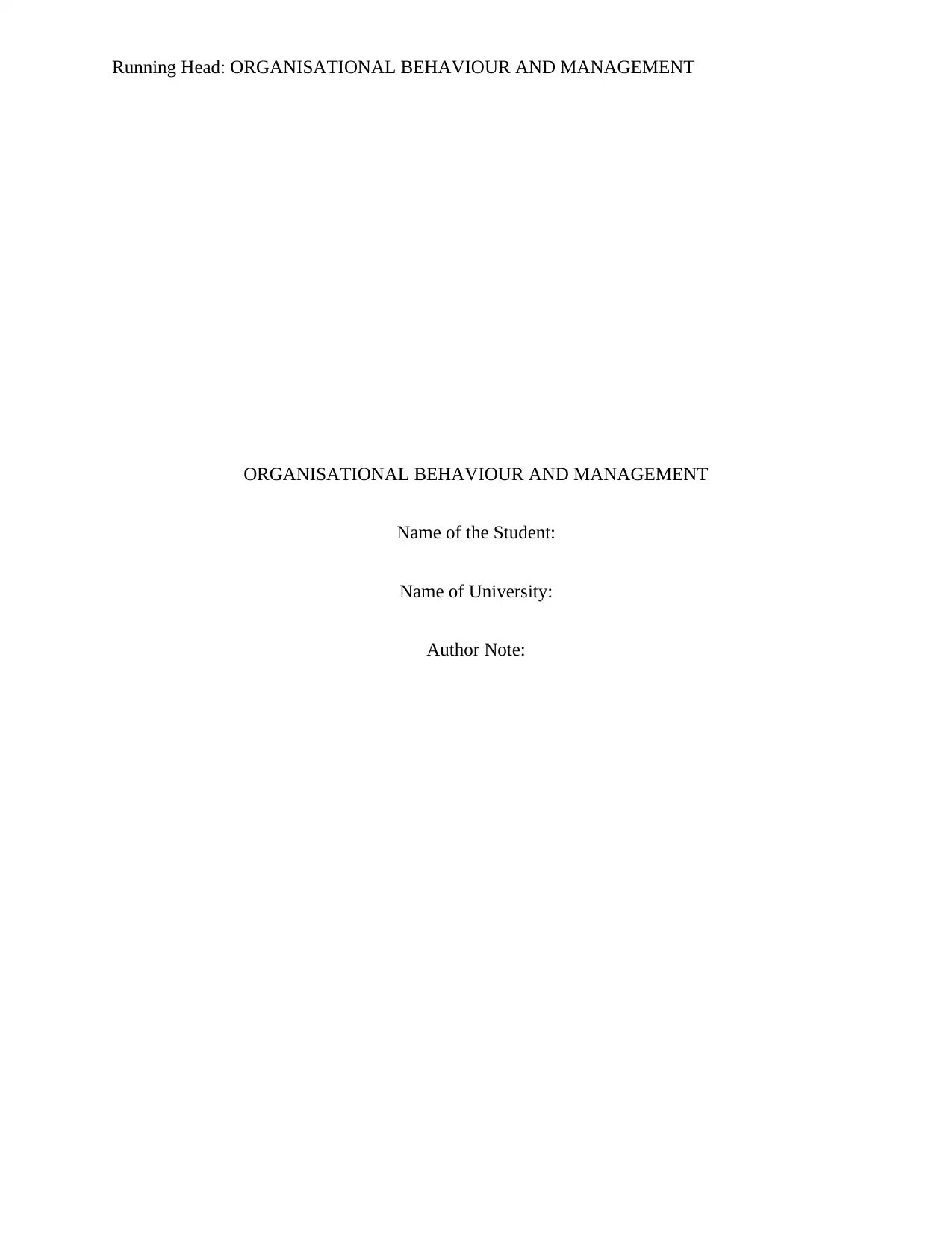
Running Head: ORGANISATIONAL BEHAVIOUR AND MANAGEMENT
ORGANISATIONAL BEHAVIOUR AND MANAGEMENT
Name of the Student:
Name of University:
Author Note:
ORGANISATIONAL BEHAVIOUR AND MANAGEMENT
Name of the Student:
Name of University:
Author Note:
Paraphrase This Document
Need a fresh take? Get an instant paraphrase of this document with our AI Paraphraser
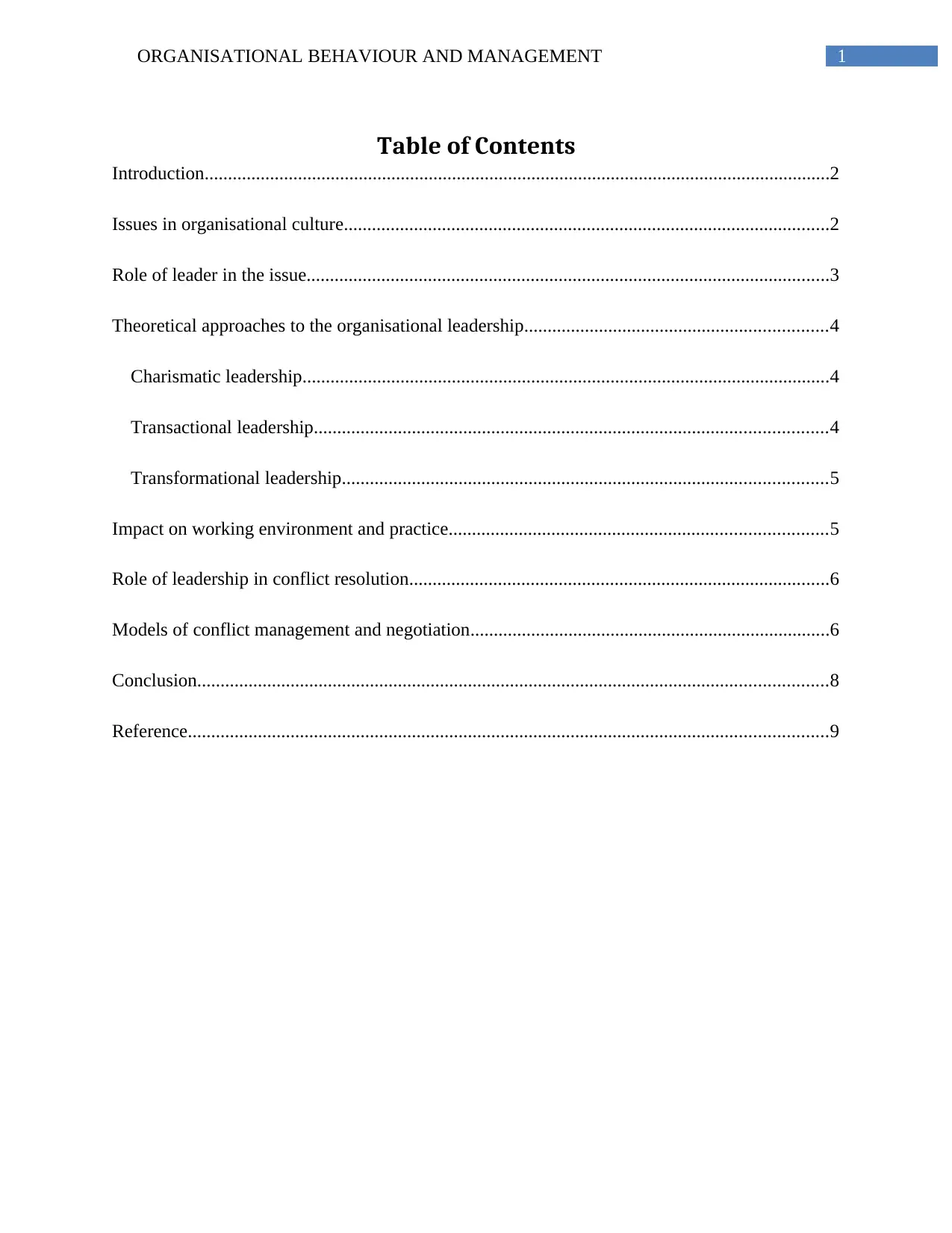
1ORGANISATIONAL BEHAVIOUR AND MANAGEMENT
Table of Contents
Introduction......................................................................................................................................2
Issues in organisational culture........................................................................................................2
Role of leader in the issue................................................................................................................3
Theoretical approaches to the organisational leadership.................................................................4
Charismatic leadership.................................................................................................................4
Transactional leadership..............................................................................................................4
Transformational leadership........................................................................................................5
Impact on working environment and practice.................................................................................5
Role of leadership in conflict resolution..........................................................................................6
Models of conflict management and negotiation.............................................................................6
Conclusion.......................................................................................................................................8
Reference.........................................................................................................................................9
Table of Contents
Introduction......................................................................................................................................2
Issues in organisational culture........................................................................................................2
Role of leader in the issue................................................................................................................3
Theoretical approaches to the organisational leadership.................................................................4
Charismatic leadership.................................................................................................................4
Transactional leadership..............................................................................................................4
Transformational leadership........................................................................................................5
Impact on working environment and practice.................................................................................5
Role of leadership in conflict resolution..........................................................................................6
Models of conflict management and negotiation.............................................................................6
Conclusion.......................................................................................................................................8
Reference.........................................................................................................................................9
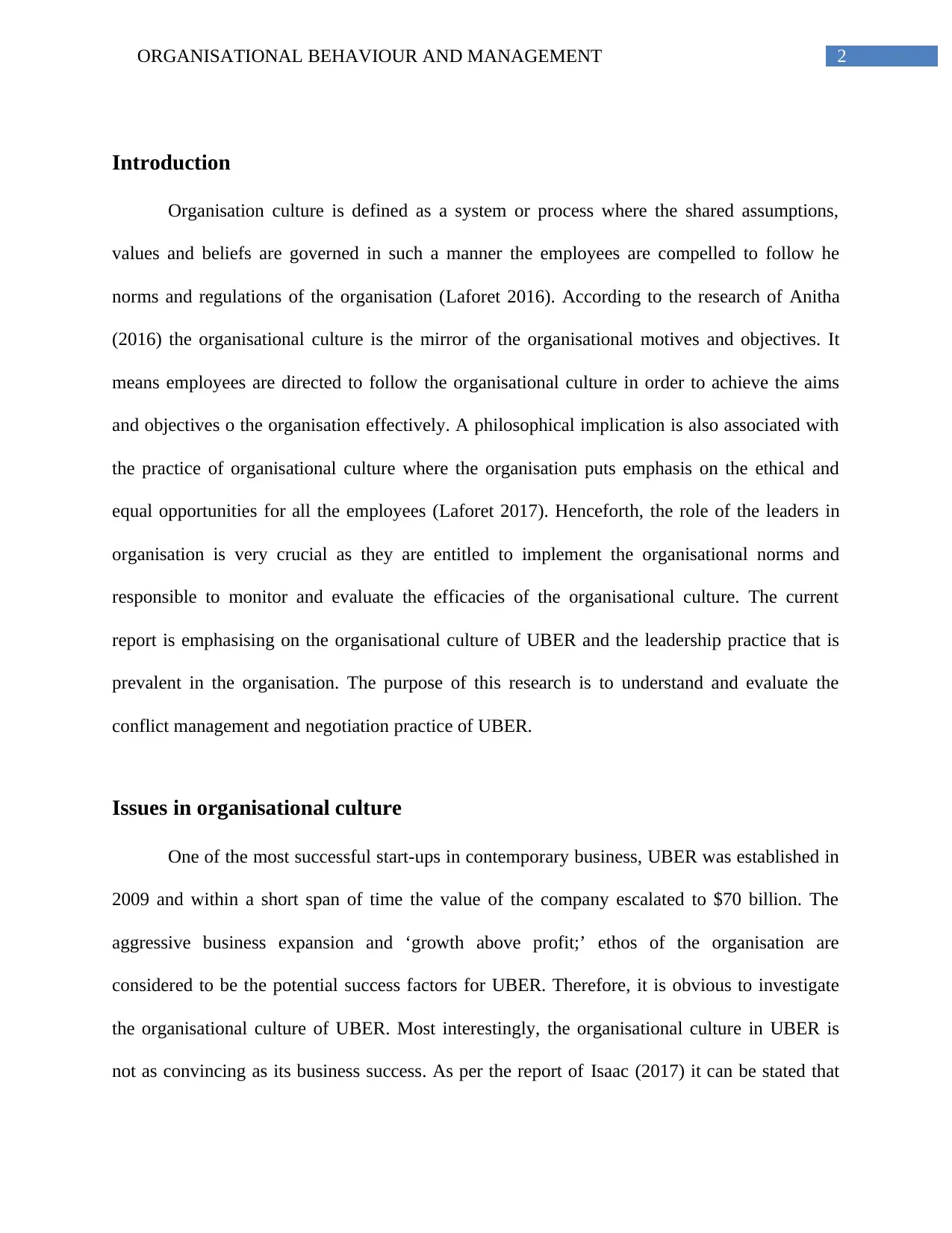
2ORGANISATIONAL BEHAVIOUR AND MANAGEMENT
Introduction
Organisation culture is defined as a system or process where the shared assumptions,
values and beliefs are governed in such a manner the employees are compelled to follow he
norms and regulations of the organisation (Laforet 2016). According to the research of Anitha
(2016) the organisational culture is the mirror of the organisational motives and objectives. It
means employees are directed to follow the organisational culture in order to achieve the aims
and objectives o the organisation effectively. A philosophical implication is also associated with
the practice of organisational culture where the organisation puts emphasis on the ethical and
equal opportunities for all the employees (Laforet 2017). Henceforth, the role of the leaders in
organisation is very crucial as they are entitled to implement the organisational norms and
responsible to monitor and evaluate the efficacies of the organisational culture. The current
report is emphasising on the organisational culture of UBER and the leadership practice that is
prevalent in the organisation. The purpose of this research is to understand and evaluate the
conflict management and negotiation practice of UBER.
Issues in organisational culture
One of the most successful start-ups in contemporary business, UBER was established in
2009 and within a short span of time the value of the company escalated to $70 billion. The
aggressive business expansion and ‘growth above profit;’ ethos of the organisation are
considered to be the potential success factors for UBER. Therefore, it is obvious to investigate
the organisational culture of UBER. Most interestingly, the organisational culture in UBER is
not as convincing as its business success. As per the report of Isaac (2017) it can be stated that
Introduction
Organisation culture is defined as a system or process where the shared assumptions,
values and beliefs are governed in such a manner the employees are compelled to follow he
norms and regulations of the organisation (Laforet 2016). According to the research of Anitha
(2016) the organisational culture is the mirror of the organisational motives and objectives. It
means employees are directed to follow the organisational culture in order to achieve the aims
and objectives o the organisation effectively. A philosophical implication is also associated with
the practice of organisational culture where the organisation puts emphasis on the ethical and
equal opportunities for all the employees (Laforet 2017). Henceforth, the role of the leaders in
organisation is very crucial as they are entitled to implement the organisational norms and
responsible to monitor and evaluate the efficacies of the organisational culture. The current
report is emphasising on the organisational culture of UBER and the leadership practice that is
prevalent in the organisation. The purpose of this research is to understand and evaluate the
conflict management and negotiation practice of UBER.
Issues in organisational culture
One of the most successful start-ups in contemporary business, UBER was established in
2009 and within a short span of time the value of the company escalated to $70 billion. The
aggressive business expansion and ‘growth above profit;’ ethos of the organisation are
considered to be the potential success factors for UBER. Therefore, it is obvious to investigate
the organisational culture of UBER. Most interestingly, the organisational culture in UBER is
not as convincing as its business success. As per the report of Isaac (2017) it can be stated that
⊘ This is a preview!⊘
Do you want full access?
Subscribe today to unlock all pages.

Trusted by 1+ million students worldwide
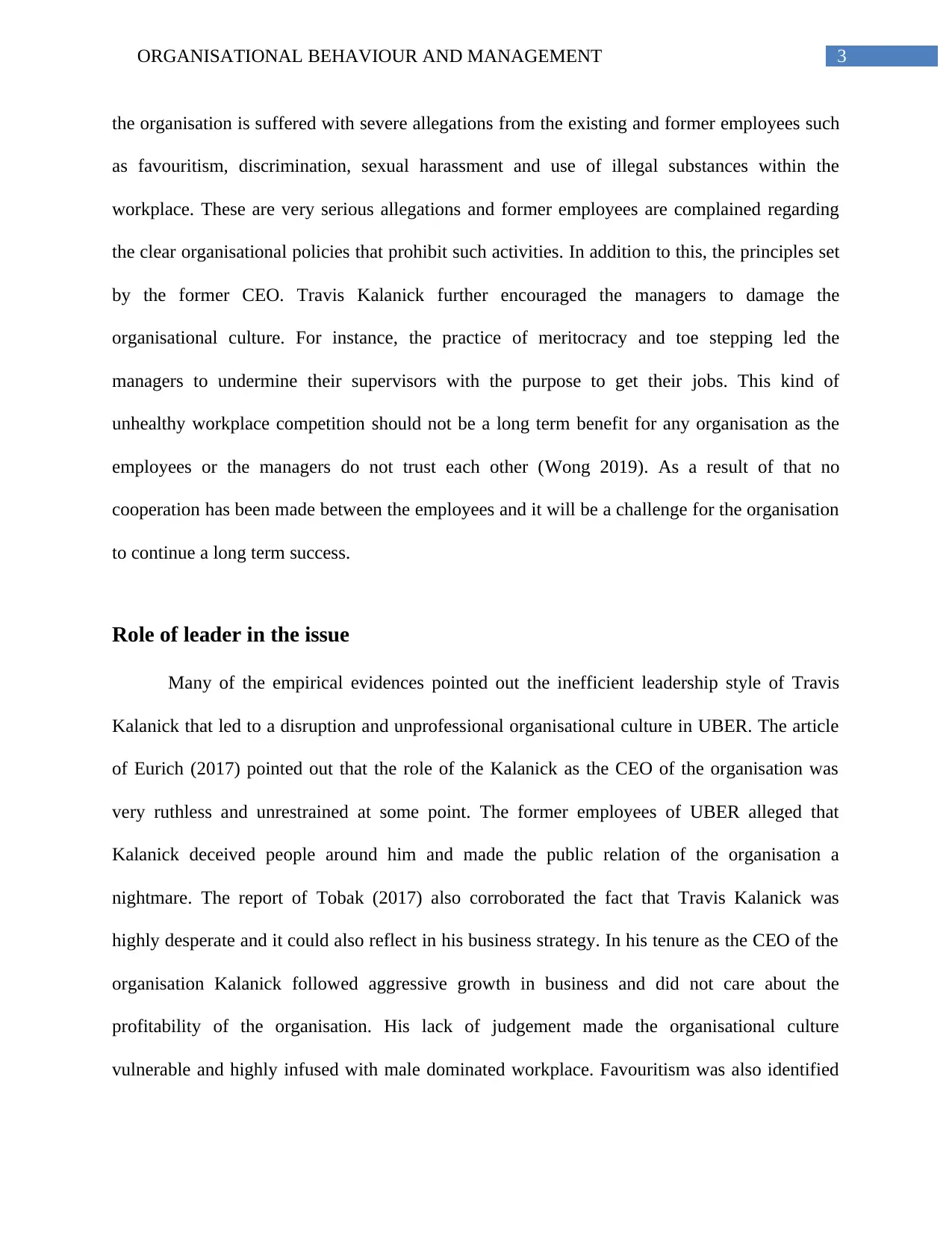
3ORGANISATIONAL BEHAVIOUR AND MANAGEMENT
the organisation is suffered with severe allegations from the existing and former employees such
as favouritism, discrimination, sexual harassment and use of illegal substances within the
workplace. These are very serious allegations and former employees are complained regarding
the clear organisational policies that prohibit such activities. In addition to this, the principles set
by the former CEO. Travis Kalanick further encouraged the managers to damage the
organisational culture. For instance, the practice of meritocracy and toe stepping led the
managers to undermine their supervisors with the purpose to get their jobs. This kind of
unhealthy workplace competition should not be a long term benefit for any organisation as the
employees or the managers do not trust each other (Wong 2019). As a result of that no
cooperation has been made between the employees and it will be a challenge for the organisation
to continue a long term success.
Role of leader in the issue
Many of the empirical evidences pointed out the inefficient leadership style of Travis
Kalanick that led to a disruption and unprofessional organisational culture in UBER. The article
of Eurich (2017) pointed out that the role of the Kalanick as the CEO of the organisation was
very ruthless and unrestrained at some point. The former employees of UBER alleged that
Kalanick deceived people around him and made the public relation of the organisation a
nightmare. The report of Tobak (2017) also corroborated the fact that Travis Kalanick was
highly desperate and it could also reflect in his business strategy. In his tenure as the CEO of the
organisation Kalanick followed aggressive growth in business and did not care about the
profitability of the organisation. His lack of judgement made the organisational culture
vulnerable and highly infused with male dominated workplace. Favouritism was also identified
the organisation is suffered with severe allegations from the existing and former employees such
as favouritism, discrimination, sexual harassment and use of illegal substances within the
workplace. These are very serious allegations and former employees are complained regarding
the clear organisational policies that prohibit such activities. In addition to this, the principles set
by the former CEO. Travis Kalanick further encouraged the managers to damage the
organisational culture. For instance, the practice of meritocracy and toe stepping led the
managers to undermine their supervisors with the purpose to get their jobs. This kind of
unhealthy workplace competition should not be a long term benefit for any organisation as the
employees or the managers do not trust each other (Wong 2019). As a result of that no
cooperation has been made between the employees and it will be a challenge for the organisation
to continue a long term success.
Role of leader in the issue
Many of the empirical evidences pointed out the inefficient leadership style of Travis
Kalanick that led to a disruption and unprofessional organisational culture in UBER. The article
of Eurich (2017) pointed out that the role of the Kalanick as the CEO of the organisation was
very ruthless and unrestrained at some point. The former employees of UBER alleged that
Kalanick deceived people around him and made the public relation of the organisation a
nightmare. The report of Tobak (2017) also corroborated the fact that Travis Kalanick was
highly desperate and it could also reflect in his business strategy. In his tenure as the CEO of the
organisation Kalanick followed aggressive growth in business and did not care about the
profitability of the organisation. His lack of judgement made the organisational culture
vulnerable and highly infused with male dominated workplace. Favouritism was also identified
Paraphrase This Document
Need a fresh take? Get an instant paraphrase of this document with our AI Paraphraser
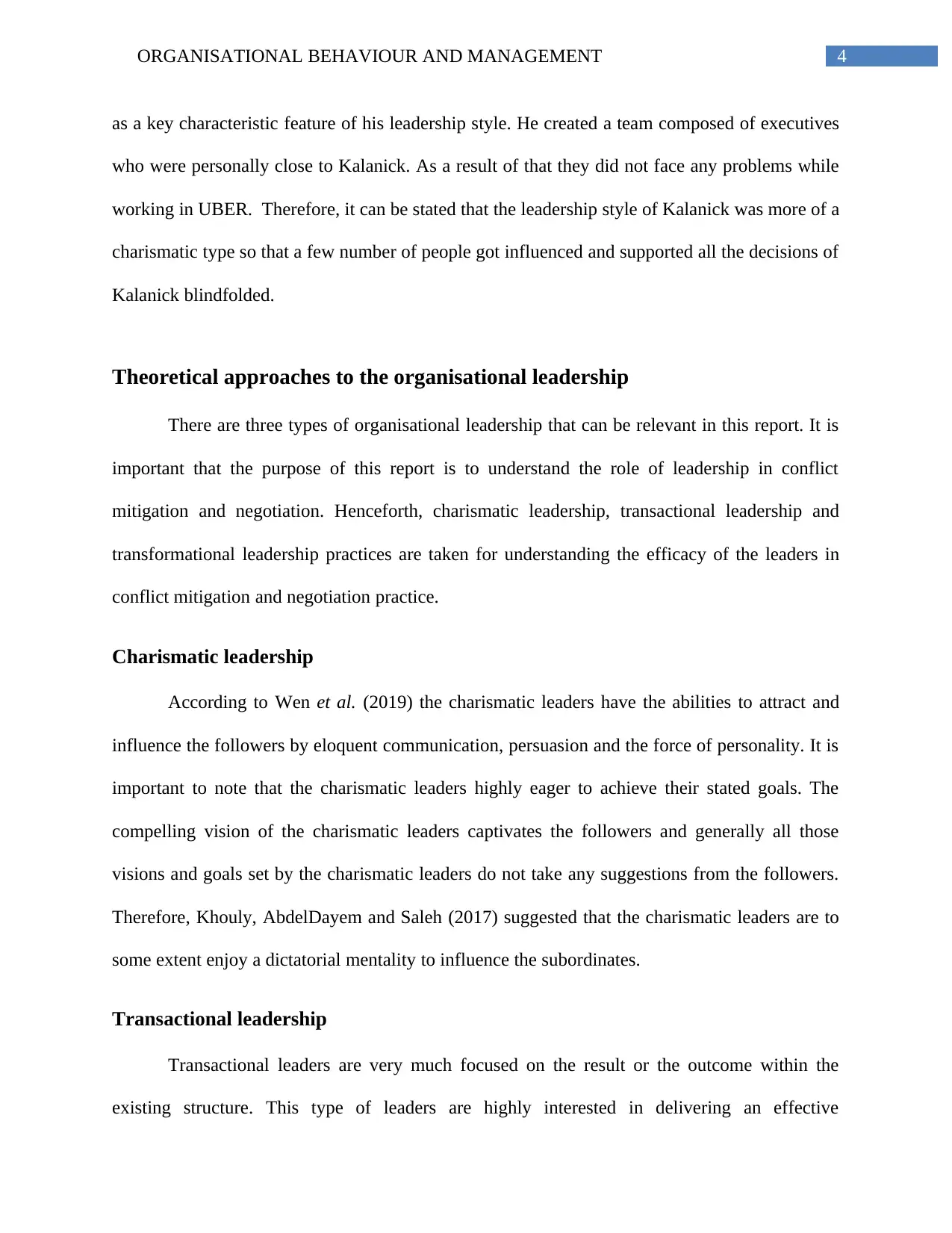
4ORGANISATIONAL BEHAVIOUR AND MANAGEMENT
as a key characteristic feature of his leadership style. He created a team composed of executives
who were personally close to Kalanick. As a result of that they did not face any problems while
working in UBER. Therefore, it can be stated that the leadership style of Kalanick was more of a
charismatic type so that a few number of people got influenced and supported all the decisions of
Kalanick blindfolded.
Theoretical approaches to the organisational leadership
There are three types of organisational leadership that can be relevant in this report. It is
important that the purpose of this report is to understand the role of leadership in conflict
mitigation and negotiation. Henceforth, charismatic leadership, transactional leadership and
transformational leadership practices are taken for understanding the efficacy of the leaders in
conflict mitigation and negotiation practice.
Charismatic leadership
According to Wen et al. (2019) the charismatic leaders have the abilities to attract and
influence the followers by eloquent communication, persuasion and the force of personality. It is
important to note that the charismatic leaders highly eager to achieve their stated goals. The
compelling vision of the charismatic leaders captivates the followers and generally all those
visions and goals set by the charismatic leaders do not take any suggestions from the followers.
Therefore, Khouly, AbdelDayem and Saleh (2017) suggested that the charismatic leaders are to
some extent enjoy a dictatorial mentality to influence the subordinates.
Transactional leadership
Transactional leaders are very much focused on the result or the outcome within the
existing structure. This type of leaders are highly interested in delivering an effective
as a key characteristic feature of his leadership style. He created a team composed of executives
who were personally close to Kalanick. As a result of that they did not face any problems while
working in UBER. Therefore, it can be stated that the leadership style of Kalanick was more of a
charismatic type so that a few number of people got influenced and supported all the decisions of
Kalanick blindfolded.
Theoretical approaches to the organisational leadership
There are three types of organisational leadership that can be relevant in this report. It is
important that the purpose of this report is to understand the role of leadership in conflict
mitigation and negotiation. Henceforth, charismatic leadership, transactional leadership and
transformational leadership practices are taken for understanding the efficacy of the leaders in
conflict mitigation and negotiation practice.
Charismatic leadership
According to Wen et al. (2019) the charismatic leaders have the abilities to attract and
influence the followers by eloquent communication, persuasion and the force of personality. It is
important to note that the charismatic leaders highly eager to achieve their stated goals. The
compelling vision of the charismatic leaders captivates the followers and generally all those
visions and goals set by the charismatic leaders do not take any suggestions from the followers.
Therefore, Khouly, AbdelDayem and Saleh (2017) suggested that the charismatic leaders are to
some extent enjoy a dictatorial mentality to influence the subordinates.
Transactional leadership
Transactional leaders are very much focused on the result or the outcome within the
existing structure. This type of leaders are highly interested in delivering an effective
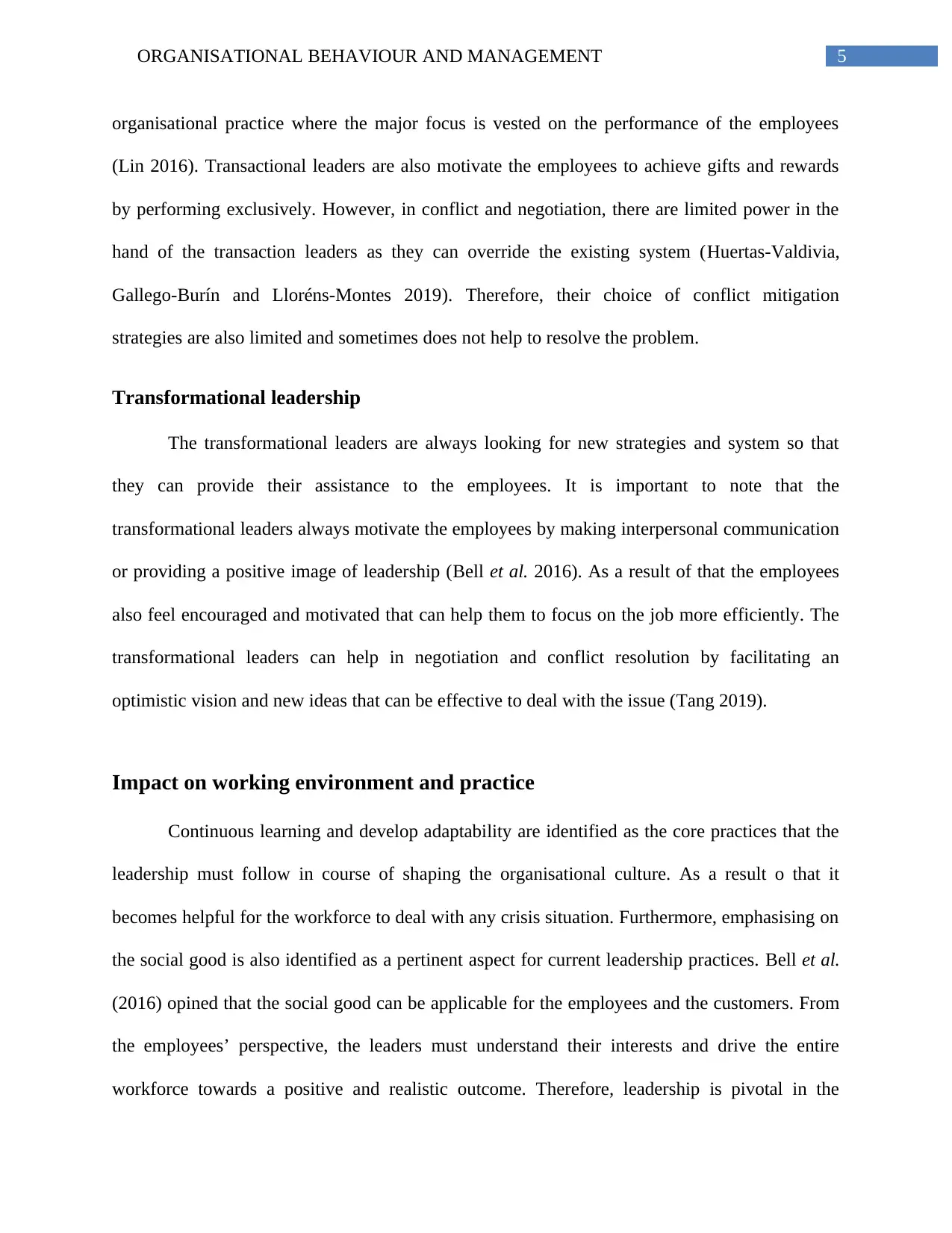
5ORGANISATIONAL BEHAVIOUR AND MANAGEMENT
organisational practice where the major focus is vested on the performance of the employees
(Lin 2016). Transactional leaders are also motivate the employees to achieve gifts and rewards
by performing exclusively. However, in conflict and negotiation, there are limited power in the
hand of the transaction leaders as they can override the existing system (Huertas-Valdivia,
Gallego-Burín and Lloréns-Montes 2019). Therefore, their choice of conflict mitigation
strategies are also limited and sometimes does not help to resolve the problem.
Transformational leadership
The transformational leaders are always looking for new strategies and system so that
they can provide their assistance to the employees. It is important to note that the
transformational leaders always motivate the employees by making interpersonal communication
or providing a positive image of leadership (Bell et al. 2016). As a result of that the employees
also feel encouraged and motivated that can help them to focus on the job more efficiently. The
transformational leaders can help in negotiation and conflict resolution by facilitating an
optimistic vision and new ideas that can be effective to deal with the issue (Tang 2019).
Impact on working environment and practice
Continuous learning and develop adaptability are identified as the core practices that the
leadership must follow in course of shaping the organisational culture. As a result o that it
becomes helpful for the workforce to deal with any crisis situation. Furthermore, emphasising on
the social good is also identified as a pertinent aspect for current leadership practices. Bell et al.
(2016) opined that the social good can be applicable for the employees and the customers. From
the employees’ perspective, the leaders must understand their interests and drive the entire
workforce towards a positive and realistic outcome. Therefore, leadership is pivotal in the
organisational practice where the major focus is vested on the performance of the employees
(Lin 2016). Transactional leaders are also motivate the employees to achieve gifts and rewards
by performing exclusively. However, in conflict and negotiation, there are limited power in the
hand of the transaction leaders as they can override the existing system (Huertas-Valdivia,
Gallego-Burín and Lloréns-Montes 2019). Therefore, their choice of conflict mitigation
strategies are also limited and sometimes does not help to resolve the problem.
Transformational leadership
The transformational leaders are always looking for new strategies and system so that
they can provide their assistance to the employees. It is important to note that the
transformational leaders always motivate the employees by making interpersonal communication
or providing a positive image of leadership (Bell et al. 2016). As a result of that the employees
also feel encouraged and motivated that can help them to focus on the job more efficiently. The
transformational leaders can help in negotiation and conflict resolution by facilitating an
optimistic vision and new ideas that can be effective to deal with the issue (Tang 2019).
Impact on working environment and practice
Continuous learning and develop adaptability are identified as the core practices that the
leadership must follow in course of shaping the organisational culture. As a result o that it
becomes helpful for the workforce to deal with any crisis situation. Furthermore, emphasising on
the social good is also identified as a pertinent aspect for current leadership practices. Bell et al.
(2016) opined that the social good can be applicable for the employees and the customers. From
the employees’ perspective, the leaders must understand their interests and drive the entire
workforce towards a positive and realistic outcome. Therefore, leadership is pivotal in the
⊘ This is a preview!⊘
Do you want full access?
Subscribe today to unlock all pages.

Trusted by 1+ million students worldwide
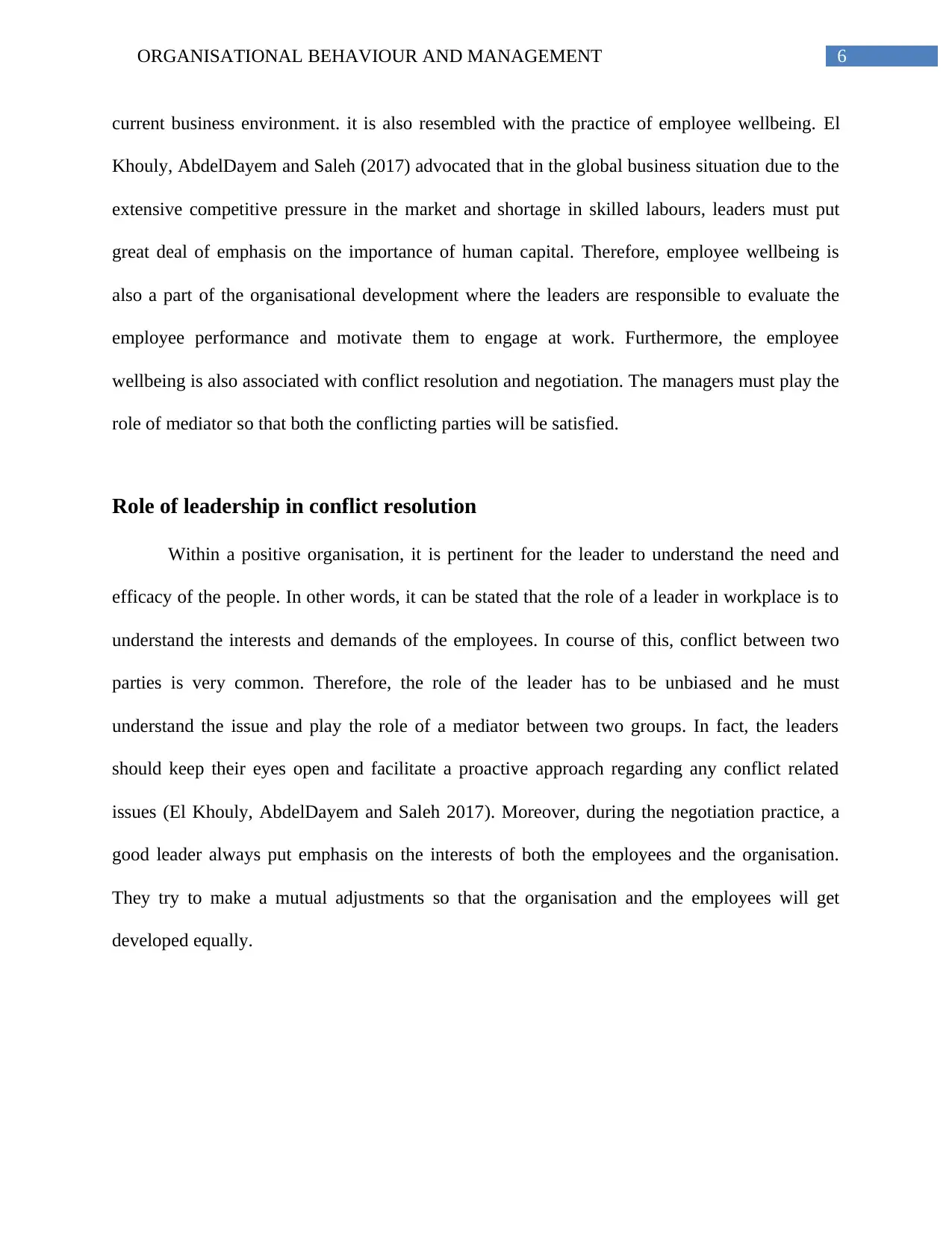
6ORGANISATIONAL BEHAVIOUR AND MANAGEMENT
current business environment. it is also resembled with the practice of employee wellbeing. El
Khouly, AbdelDayem and Saleh (2017) advocated that in the global business situation due to the
extensive competitive pressure in the market and shortage in skilled labours, leaders must put
great deal of emphasis on the importance of human capital. Therefore, employee wellbeing is
also a part of the organisational development where the leaders are responsible to evaluate the
employee performance and motivate them to engage at work. Furthermore, the employee
wellbeing is also associated with conflict resolution and negotiation. The managers must play the
role of mediator so that both the conflicting parties will be satisfied.
Role of leadership in conflict resolution
Within a positive organisation, it is pertinent for the leader to understand the need and
efficacy of the people. In other words, it can be stated that the role of a leader in workplace is to
understand the interests and demands of the employees. In course of this, conflict between two
parties is very common. Therefore, the role of the leader has to be unbiased and he must
understand the issue and play the role of a mediator between two groups. In fact, the leaders
should keep their eyes open and facilitate a proactive approach regarding any conflict related
issues (El Khouly, AbdelDayem and Saleh 2017). Moreover, during the negotiation practice, a
good leader always put emphasis on the interests of both the employees and the organisation.
They try to make a mutual adjustments so that the organisation and the employees will get
developed equally.
current business environment. it is also resembled with the practice of employee wellbeing. El
Khouly, AbdelDayem and Saleh (2017) advocated that in the global business situation due to the
extensive competitive pressure in the market and shortage in skilled labours, leaders must put
great deal of emphasis on the importance of human capital. Therefore, employee wellbeing is
also a part of the organisational development where the leaders are responsible to evaluate the
employee performance and motivate them to engage at work. Furthermore, the employee
wellbeing is also associated with conflict resolution and negotiation. The managers must play the
role of mediator so that both the conflicting parties will be satisfied.
Role of leadership in conflict resolution
Within a positive organisation, it is pertinent for the leader to understand the need and
efficacy of the people. In other words, it can be stated that the role of a leader in workplace is to
understand the interests and demands of the employees. In course of this, conflict between two
parties is very common. Therefore, the role of the leader has to be unbiased and he must
understand the issue and play the role of a mediator between two groups. In fact, the leaders
should keep their eyes open and facilitate a proactive approach regarding any conflict related
issues (El Khouly, AbdelDayem and Saleh 2017). Moreover, during the negotiation practice, a
good leader always put emphasis on the interests of both the employees and the organisation.
They try to make a mutual adjustments so that the organisation and the employees will get
developed equally.
Paraphrase This Document
Need a fresh take? Get an instant paraphrase of this document with our AI Paraphraser
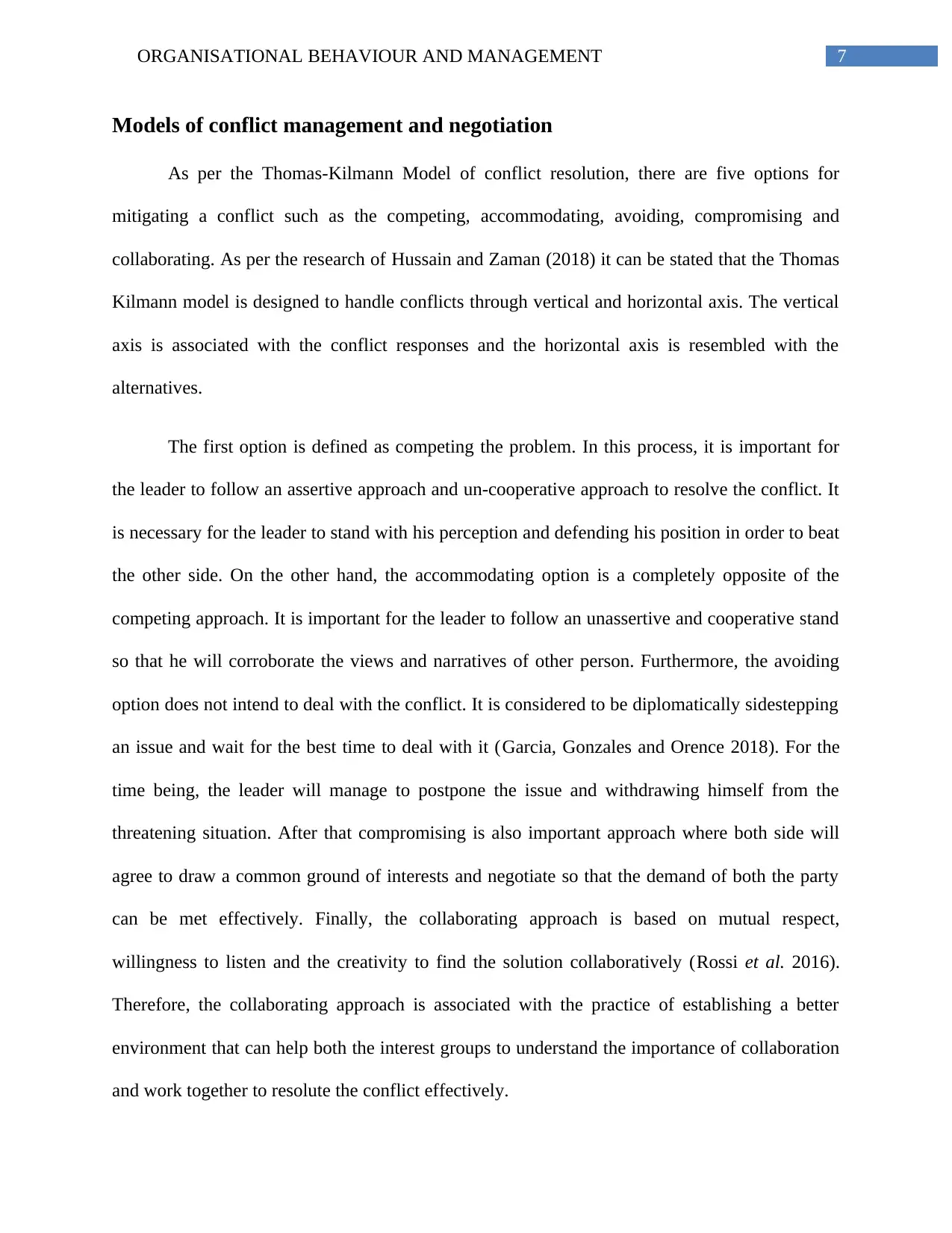
7ORGANISATIONAL BEHAVIOUR AND MANAGEMENT
Models of conflict management and negotiation
As per the Thomas-Kilmann Model of conflict resolution, there are five options for
mitigating a conflict such as the competing, accommodating, avoiding, compromising and
collaborating. As per the research of Hussain and Zaman (2018) it can be stated that the Thomas
Kilmann model is designed to handle conflicts through vertical and horizontal axis. The vertical
axis is associated with the conflict responses and the horizontal axis is resembled with the
alternatives.
The first option is defined as competing the problem. In this process, it is important for
the leader to follow an assertive approach and un-cooperative approach to resolve the conflict. It
is necessary for the leader to stand with his perception and defending his position in order to beat
the other side. On the other hand, the accommodating option is a completely opposite of the
competing approach. It is important for the leader to follow an unassertive and cooperative stand
so that he will corroborate the views and narratives of other person. Furthermore, the avoiding
option does not intend to deal with the conflict. It is considered to be diplomatically sidestepping
an issue and wait for the best time to deal with it (Garcia, Gonzales and Orence 2018). For the
time being, the leader will manage to postpone the issue and withdrawing himself from the
threatening situation. After that compromising is also important approach where both side will
agree to draw a common ground of interests and negotiate so that the demand of both the party
can be met effectively. Finally, the collaborating approach is based on mutual respect,
willingness to listen and the creativity to find the solution collaboratively (Rossi et al. 2016).
Therefore, the collaborating approach is associated with the practice of establishing a better
environment that can help both the interest groups to understand the importance of collaboration
and work together to resolute the conflict effectively.
Models of conflict management and negotiation
As per the Thomas-Kilmann Model of conflict resolution, there are five options for
mitigating a conflict such as the competing, accommodating, avoiding, compromising and
collaborating. As per the research of Hussain and Zaman (2018) it can be stated that the Thomas
Kilmann model is designed to handle conflicts through vertical and horizontal axis. The vertical
axis is associated with the conflict responses and the horizontal axis is resembled with the
alternatives.
The first option is defined as competing the problem. In this process, it is important for
the leader to follow an assertive approach and un-cooperative approach to resolve the conflict. It
is necessary for the leader to stand with his perception and defending his position in order to beat
the other side. On the other hand, the accommodating option is a completely opposite of the
competing approach. It is important for the leader to follow an unassertive and cooperative stand
so that he will corroborate the views and narratives of other person. Furthermore, the avoiding
option does not intend to deal with the conflict. It is considered to be diplomatically sidestepping
an issue and wait for the best time to deal with it (Garcia, Gonzales and Orence 2018). For the
time being, the leader will manage to postpone the issue and withdrawing himself from the
threatening situation. After that compromising is also important approach where both side will
agree to draw a common ground of interests and negotiate so that the demand of both the party
can be met effectively. Finally, the collaborating approach is based on mutual respect,
willingness to listen and the creativity to find the solution collaboratively (Rossi et al. 2016).
Therefore, the collaborating approach is associated with the practice of establishing a better
environment that can help both the interest groups to understand the importance of collaboration
and work together to resolute the conflict effectively.
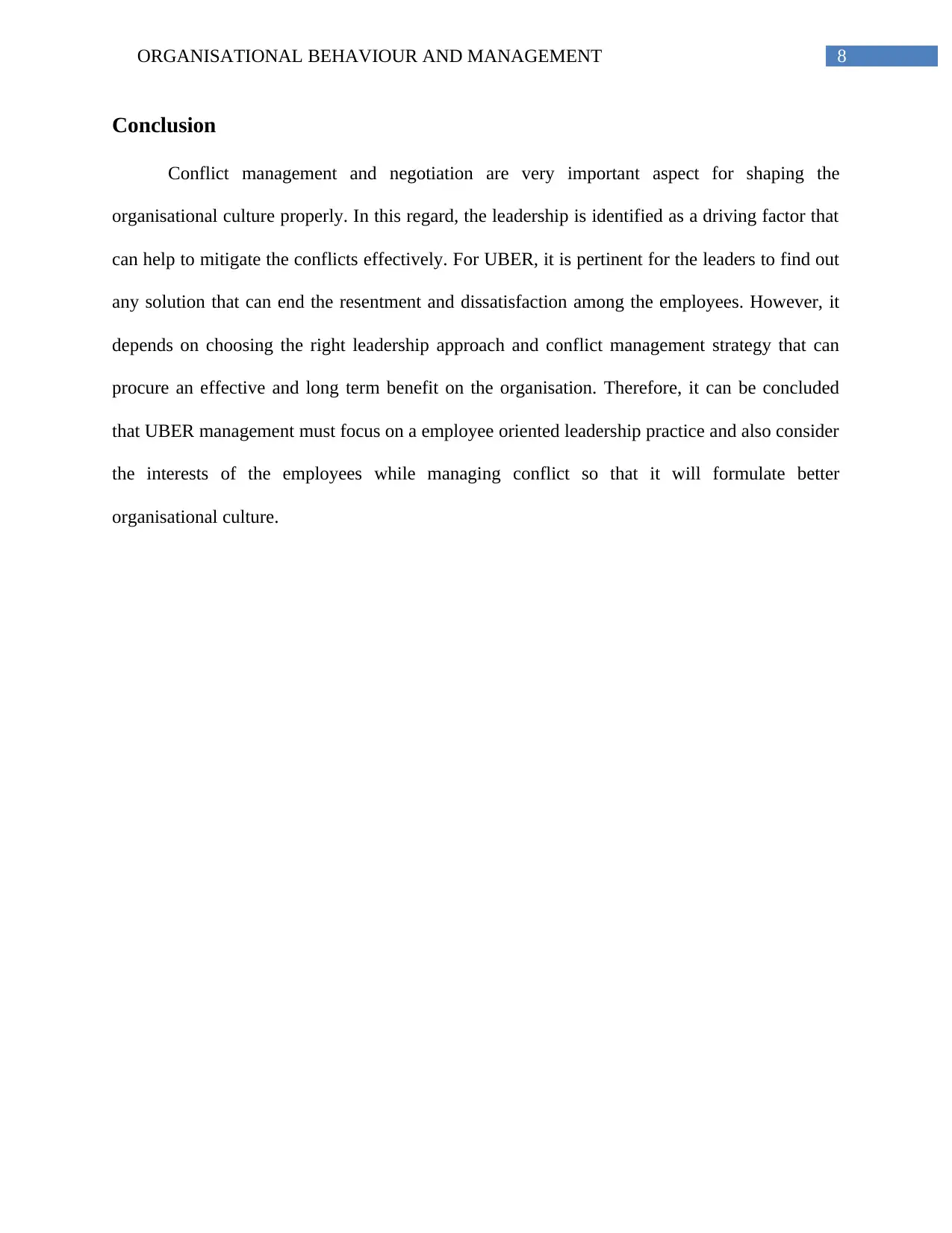
8ORGANISATIONAL BEHAVIOUR AND MANAGEMENT
Conclusion
Conflict management and negotiation are very important aspect for shaping the
organisational culture properly. In this regard, the leadership is identified as a driving factor that
can help to mitigate the conflicts effectively. For UBER, it is pertinent for the leaders to find out
any solution that can end the resentment and dissatisfaction among the employees. However, it
depends on choosing the right leadership approach and conflict management strategy that can
procure an effective and long term benefit on the organisation. Therefore, it can be concluded
that UBER management must focus on a employee oriented leadership practice and also consider
the interests of the employees while managing conflict so that it will formulate better
organisational culture.
Conclusion
Conflict management and negotiation are very important aspect for shaping the
organisational culture properly. In this regard, the leadership is identified as a driving factor that
can help to mitigate the conflicts effectively. For UBER, it is pertinent for the leaders to find out
any solution that can end the resentment and dissatisfaction among the employees. However, it
depends on choosing the right leadership approach and conflict management strategy that can
procure an effective and long term benefit on the organisation. Therefore, it can be concluded
that UBER management must focus on a employee oriented leadership practice and also consider
the interests of the employees while managing conflict so that it will formulate better
organisational culture.
⊘ This is a preview!⊘
Do you want full access?
Subscribe today to unlock all pages.

Trusted by 1+ million students worldwide
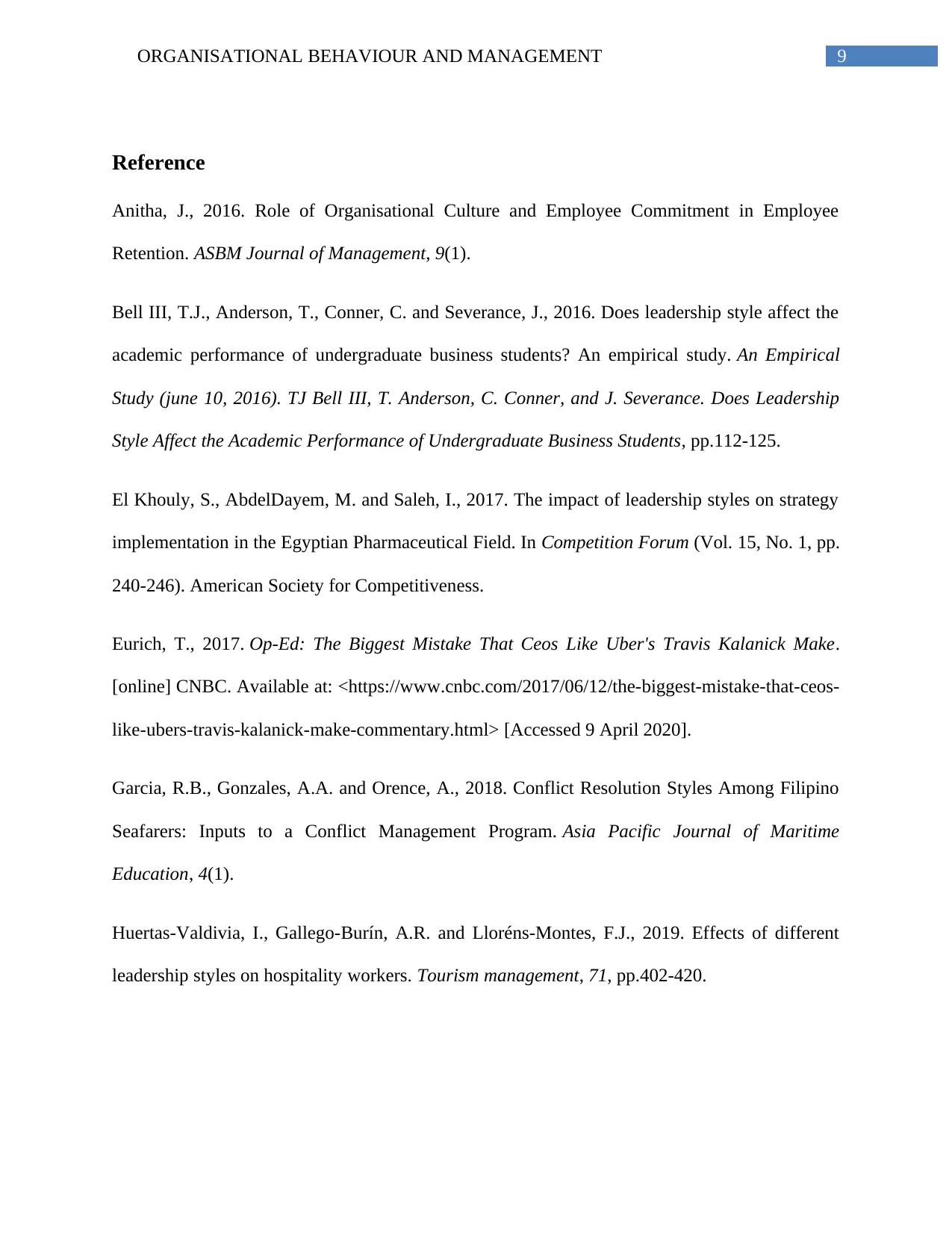
9ORGANISATIONAL BEHAVIOUR AND MANAGEMENT
Reference
Anitha, J., 2016. Role of Organisational Culture and Employee Commitment in Employee
Retention. ASBM Journal of Management, 9(1).
Bell III, T.J., Anderson, T., Conner, C. and Severance, J., 2016. Does leadership style affect the
academic performance of undergraduate business students? An empirical study. An Empirical
Study (june 10, 2016). TJ Bell III, T. Anderson, C. Conner, and J. Severance. Does Leadership
Style Affect the Academic Performance of Undergraduate Business Students, pp.112-125.
El Khouly, S., AbdelDayem, M. and Saleh, I., 2017. The impact of leadership styles on strategy
implementation in the Egyptian Pharmaceutical Field. In Competition Forum (Vol. 15, No. 1, pp.
240-246). American Society for Competitiveness.
Eurich, T., 2017. Op-Ed: The Biggest Mistake That Ceos Like Uber's Travis Kalanick Make.
[online] CNBC. Available at: <https://www.cnbc.com/2017/06/12/the-biggest-mistake-that-ceos-
like-ubers-travis-kalanick-make-commentary.html> [Accessed 9 April 2020].
Garcia, R.B., Gonzales, A.A. and Orence, A., 2018. Conflict Resolution Styles Among Filipino
Seafarers: Inputs to a Conflict Management Program. Asia Pacific Journal of Maritime
Education, 4(1).
Huertas-Valdivia, I., Gallego-Burín, A.R. and Lloréns-Montes, F.J., 2019. Effects of different
leadership styles on hospitality workers. Tourism management, 71, pp.402-420.
Reference
Anitha, J., 2016. Role of Organisational Culture and Employee Commitment in Employee
Retention. ASBM Journal of Management, 9(1).
Bell III, T.J., Anderson, T., Conner, C. and Severance, J., 2016. Does leadership style affect the
academic performance of undergraduate business students? An empirical study. An Empirical
Study (june 10, 2016). TJ Bell III, T. Anderson, C. Conner, and J. Severance. Does Leadership
Style Affect the Academic Performance of Undergraduate Business Students, pp.112-125.
El Khouly, S., AbdelDayem, M. and Saleh, I., 2017. The impact of leadership styles on strategy
implementation in the Egyptian Pharmaceutical Field. In Competition Forum (Vol. 15, No. 1, pp.
240-246). American Society for Competitiveness.
Eurich, T., 2017. Op-Ed: The Biggest Mistake That Ceos Like Uber's Travis Kalanick Make.
[online] CNBC. Available at: <https://www.cnbc.com/2017/06/12/the-biggest-mistake-that-ceos-
like-ubers-travis-kalanick-make-commentary.html> [Accessed 9 April 2020].
Garcia, R.B., Gonzales, A.A. and Orence, A., 2018. Conflict Resolution Styles Among Filipino
Seafarers: Inputs to a Conflict Management Program. Asia Pacific Journal of Maritime
Education, 4(1).
Huertas-Valdivia, I., Gallego-Burín, A.R. and Lloréns-Montes, F.J., 2019. Effects of different
leadership styles on hospitality workers. Tourism management, 71, pp.402-420.
Paraphrase This Document
Need a fresh take? Get an instant paraphrase of this document with our AI Paraphraser
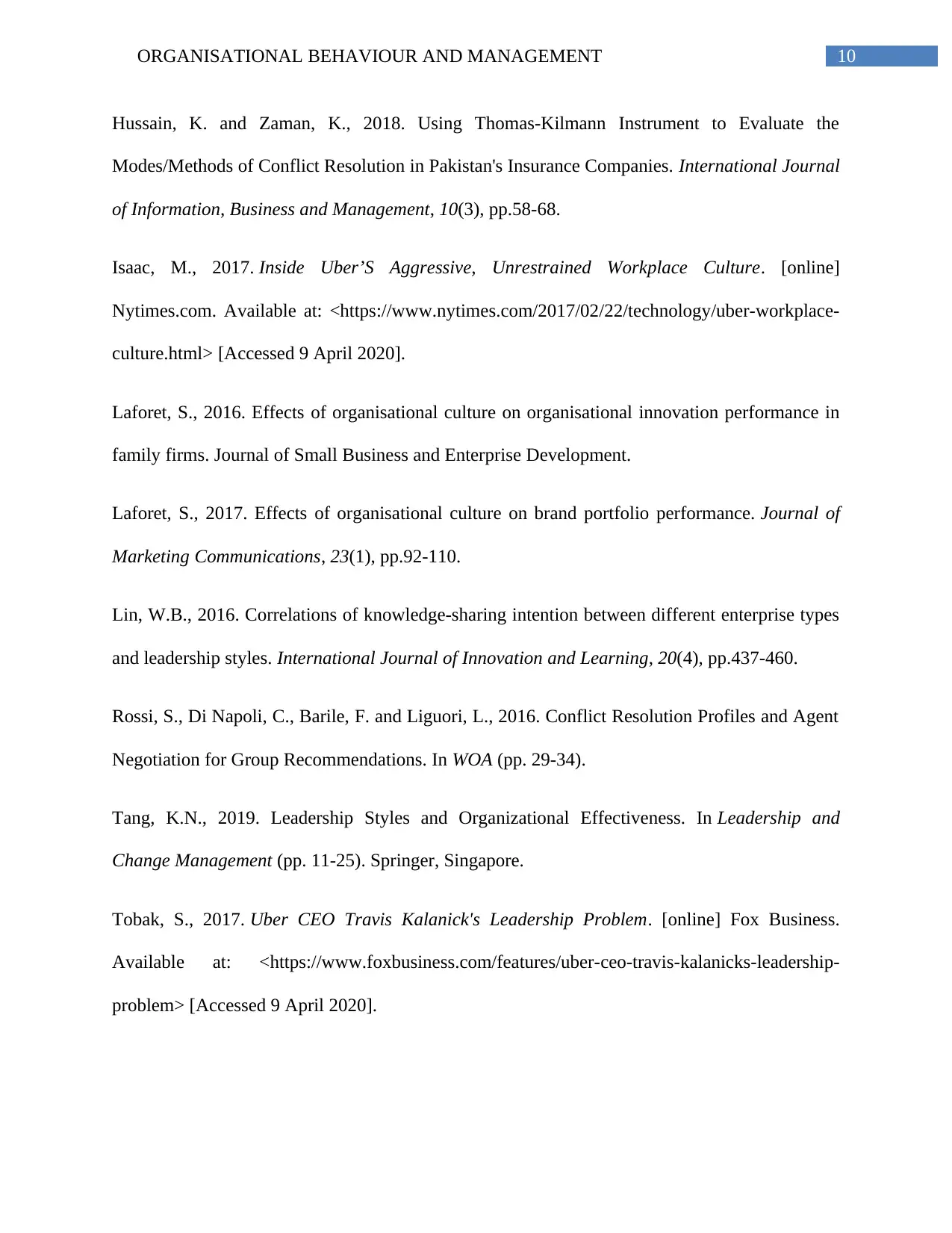
10ORGANISATIONAL BEHAVIOUR AND MANAGEMENT
Hussain, K. and Zaman, K., 2018. Using Thomas-Kilmann Instrument to Evaluate the
Modes/Methods of Conflict Resolution in Pakistan's Insurance Companies. International Journal
of Information, Business and Management, 10(3), pp.58-68.
Isaac, M., 2017. Inside Uber’S Aggressive, Unrestrained Workplace Culture. [online]
Nytimes.com. Available at: <https://www.nytimes.com/2017/02/22/technology/uber-workplace-
culture.html> [Accessed 9 April 2020].
Laforet, S., 2016. Effects of organisational culture on organisational innovation performance in
family firms. Journal of Small Business and Enterprise Development.
Laforet, S., 2017. Effects of organisational culture on brand portfolio performance. Journal of
Marketing Communications, 23(1), pp.92-110.
Lin, W.B., 2016. Correlations of knowledge-sharing intention between different enterprise types
and leadership styles. International Journal of Innovation and Learning, 20(4), pp.437-460.
Rossi, S., Di Napoli, C., Barile, F. and Liguori, L., 2016. Conflict Resolution Profiles and Agent
Negotiation for Group Recommendations. In WOA (pp. 29-34).
Tang, K.N., 2019. Leadership Styles and Organizational Effectiveness. In Leadership and
Change Management (pp. 11-25). Springer, Singapore.
Tobak, S., 2017. Uber CEO Travis Kalanick's Leadership Problem. [online] Fox Business.
Available at: <https://www.foxbusiness.com/features/uber-ceo-travis-kalanicks-leadership-
problem> [Accessed 9 April 2020].
Hussain, K. and Zaman, K., 2018. Using Thomas-Kilmann Instrument to Evaluate the
Modes/Methods of Conflict Resolution in Pakistan's Insurance Companies. International Journal
of Information, Business and Management, 10(3), pp.58-68.
Isaac, M., 2017. Inside Uber’S Aggressive, Unrestrained Workplace Culture. [online]
Nytimes.com. Available at: <https://www.nytimes.com/2017/02/22/technology/uber-workplace-
culture.html> [Accessed 9 April 2020].
Laforet, S., 2016. Effects of organisational culture on organisational innovation performance in
family firms. Journal of Small Business and Enterprise Development.
Laforet, S., 2017. Effects of organisational culture on brand portfolio performance. Journal of
Marketing Communications, 23(1), pp.92-110.
Lin, W.B., 2016. Correlations of knowledge-sharing intention between different enterprise types
and leadership styles. International Journal of Innovation and Learning, 20(4), pp.437-460.
Rossi, S., Di Napoli, C., Barile, F. and Liguori, L., 2016. Conflict Resolution Profiles and Agent
Negotiation for Group Recommendations. In WOA (pp. 29-34).
Tang, K.N., 2019. Leadership Styles and Organizational Effectiveness. In Leadership and
Change Management (pp. 11-25). Springer, Singapore.
Tobak, S., 2017. Uber CEO Travis Kalanick's Leadership Problem. [online] Fox Business.
Available at: <https://www.foxbusiness.com/features/uber-ceo-travis-kalanicks-leadership-
problem> [Accessed 9 April 2020].
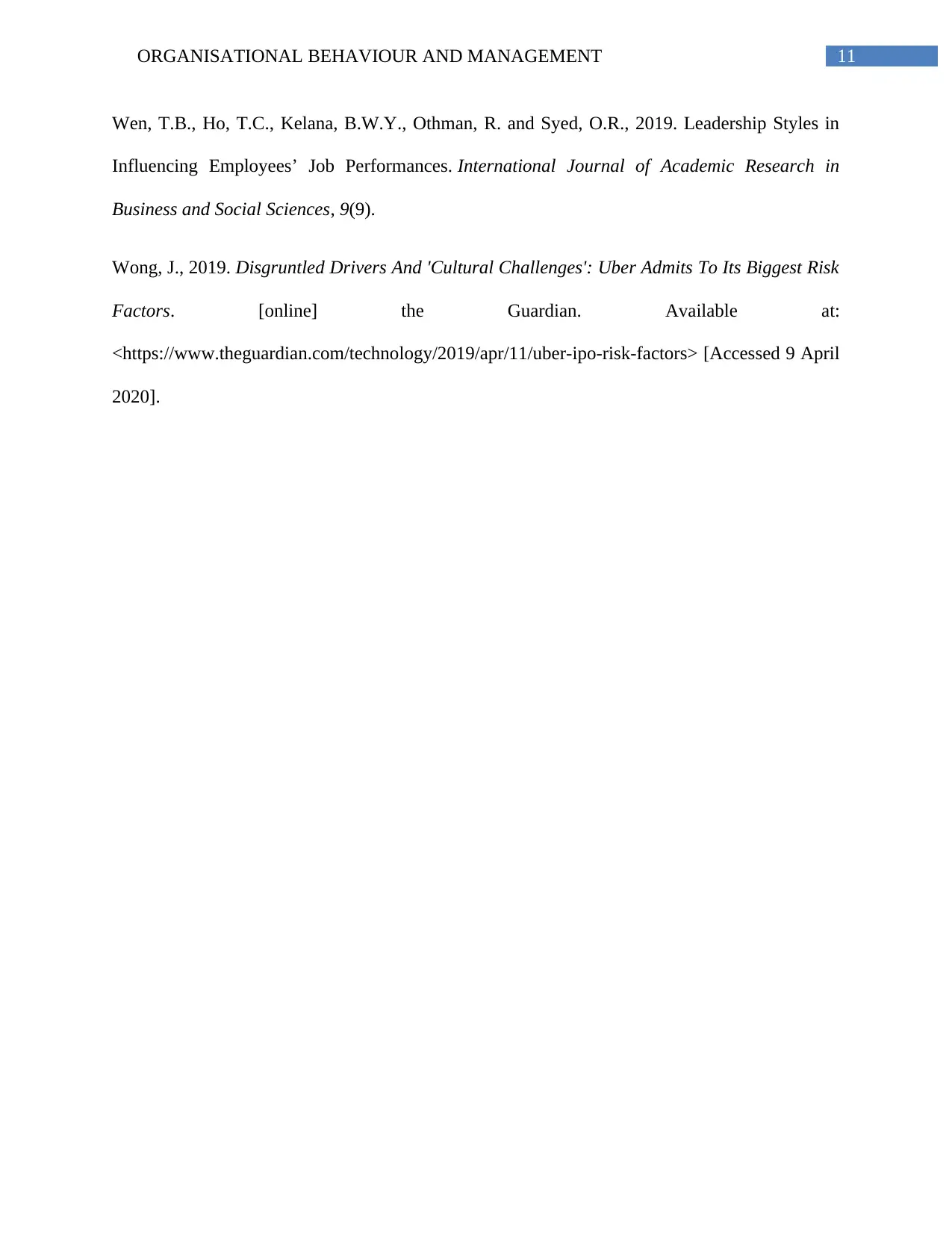
11ORGANISATIONAL BEHAVIOUR AND MANAGEMENT
Wen, T.B., Ho, T.C., Kelana, B.W.Y., Othman, R. and Syed, O.R., 2019. Leadership Styles in
Influencing Employees’ Job Performances. International Journal of Academic Research in
Business and Social Sciences, 9(9).
Wong, J., 2019. Disgruntled Drivers And 'Cultural Challenges': Uber Admits To Its Biggest Risk
Factors. [online] the Guardian. Available at:
<https://www.theguardian.com/technology/2019/apr/11/uber-ipo-risk-factors> [Accessed 9 April
2020].
Wen, T.B., Ho, T.C., Kelana, B.W.Y., Othman, R. and Syed, O.R., 2019. Leadership Styles in
Influencing Employees’ Job Performances. International Journal of Academic Research in
Business and Social Sciences, 9(9).
Wong, J., 2019. Disgruntled Drivers And 'Cultural Challenges': Uber Admits To Its Biggest Risk
Factors. [online] the Guardian. Available at:
<https://www.theguardian.com/technology/2019/apr/11/uber-ipo-risk-factors> [Accessed 9 April
2020].
⊘ This is a preview!⊘
Do you want full access?
Subscribe today to unlock all pages.

Trusted by 1+ million students worldwide
1 out of 12
Related Documents
Your All-in-One AI-Powered Toolkit for Academic Success.
+13062052269
info@desklib.com
Available 24*7 on WhatsApp / Email
![[object Object]](/_next/static/media/star-bottom.7253800d.svg)
Unlock your academic potential
Copyright © 2020–2025 A2Z Services. All Rights Reserved. Developed and managed by ZUCOL.





